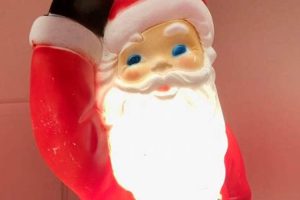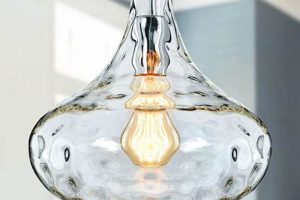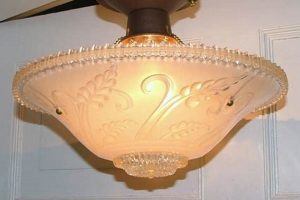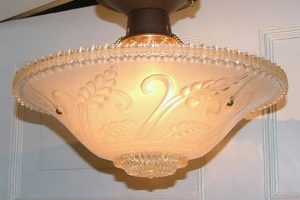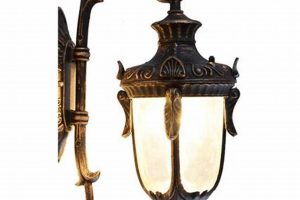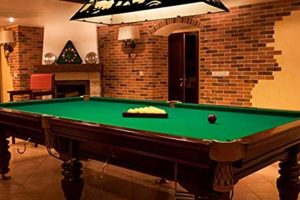These lighting devices, originating in the mid-20th century, feature small bulbs containing a volatile liquid, typically methylene chloride, that bubbles when the bulb is illuminated and heats up. This creates a visually distinctive and charming effect, replicating a miniature effervescent display within each individual light. Examples often include strings of lights with candelabra-style bulbs connected by green or brown wire.
Their enduring popularity stems from a combination of nostalgia, aesthetic appeal, and relative scarcity. They evoke memories of past holiday seasons and provide a unique visual texture that is markedly different from modern LED Christmas lights. The lights frequently appear in antique shops and online marketplaces, purchased by collectors and individuals seeking to recapture a classic holiday ambiance. They can serve as a conversation piece, adding a touch of vintage flair to holiday decorations.
The following sections will detail the history, common variations, safe handling practices, and methods for troubleshooting issues that may arise with these classic decorative items, ensuring their continued enjoyment for years to come.
Guidance for Maintaining and Enjoying Classic Holiday Lighting
The following guidelines address the proper care, usage, and troubleshooting of vintage bubble lights, ensuring both longevity and safety. Adherence to these recommendations will maximize the lifespan and enjoyment of these decorative items.
Tip 1: Inspect Thoroughly Before Use: Before each season, examine the wiring for cracks, fraying, or exposed conductors. Replace any compromised cords to mitigate the risk of electrical hazards. Ensure all bulbs are securely fastened.
Tip 2: Use Appropriate Replacement Bulbs: When a bulb fails, utilize only replacement bulbs that are specifically designed for use in bubble light strings. Incorrect bulb wattage can cause overheating or improper bubbling.
Tip 3: Store Properly When Not in Use: Carefully wrap each string of lights and store it in a cool, dry location, away from direct sunlight and extreme temperatures. This prevents degradation of the wiring and premature bulb failure.
Tip 4: Avoid Overloading Circuits: Do not connect too many strands of lights to a single electrical outlet. Overloading can trip circuit breakers or, in severe cases, lead to electrical fires. Consult the manufacturer’s recommendations for the maximum number of connectable strands.
Tip 5: Handle with Care: Vintage bubble lights are often fragile. Avoid dropping or subjecting them to rough handling. The glass bulbs are susceptible to breakage, and the internal components can be damaged by impact.
Tip 6: Monitor for Overheating: Periodically check the lights during operation for signs of overheating, such as a burning smell or unusually hot bulbs. Disconnect the lights immediately if overheating is detected.
Tip 7: Consider a Timed Outlet: Using a timed outlet is ideal to prevent forgetting and to save energy. Lights can stay for a predetermined amount of time, then power off, making it safe for children.
By following these instructions, individuals can help to keep the classic lighting in prime condition, offering decorative flair for several holidays. By taking care of the lights, future generations can appreciate the vintage lighting.
The subsequent sections will delve into historical contexts, artistic value, and market values.
1. Nostalgia
The enduring appeal of classic holiday lights is inextricably linked to nostalgia, a powerful emotional connection to past experiences. These lights often represent a tangible link to childhood memories of family gatherings and festive traditions. The visual and auditory effect the gentle bubbling and soft glow triggers a sensory recall, evoking emotions associated with simpler times. This nostalgic connection drives the acquisition and preservation of these lights, transforming them from mere decorative items into cherished artifacts.
Consider, for example, individuals who recall their grandparents adorning the family Christmas tree with such lights. The act of displaying the same lights in their own homes becomes a ritual, a continuation of tradition, and a means of honoring those memories. The lights, therefore, serve as more than just illumination; they act as potent symbols of familial heritage and personal history. The scarcity of intact, functioning examples further enhances their value, as owning them represents a connection to a fading past.
In summary, nostalgia is a crucial factor in understanding the sustained popularity and value of these classic lights. This emotional connection not only drives consumer demand but also shapes the way these lights are perceived and utilized. The association with past holidays makes them more than just decorations; they become symbols of family, tradition, and personal history, ensuring their preservation for future generations.
2. Collectible
The collectible status of vintage bubble lights significantly influences their market value and desirability. This arises from several factors, including their limited production lifespan, the fragility of their construction, and the emotional resonance they hold for many individuals. As a result, intact and functioning sets of vintage bubble lights are actively sought after by collectors, driving up prices, especially for those in pristine condition with original packaging. The effect of being “collectible” transforms these lights from mere decorations into valuable artifacts, subject to the dynamics of supply and demand within the collectibles market. A prime example is the escalating prices observed at online auctions and antique sales, reflecting the competition among collectors to acquire these scarce items.
Several elements contribute to their desirability as collectibles. Rarity, often dictated by age and survival rates, plays a crucial role. Originality, including intact packaging and unaltered condition, further elevates their value. The presence of desirable features, such as specific bulb designs or unique color combinations, can also significantly impact their appeal to collectors. Understanding these factors is essential for individuals interested in appraising or acquiring these lights, as it informs their assessment of market value and authenticity. The practical application of this knowledge extends to proper storage and maintenance, aimed at preserving the item’s condition and enhancing its collectibility over time.
In summary, the “collectible” aspect of vintage bubble lights is a pivotal component driving their value and demand. The scarcity and nostalgic connection attached to these items contribute to their appeal among collectors. Knowledge of the characteristics that define collectibility aids in assessing their true worth and ensuring their preservation. This understanding transcends mere appreciation, encompassing practical aspects such as valuation, storage, and responsible acquisition practices.
3. Methylene Chloride
Methylene chloride, also known as dichloromethane, is the volatile liquid responsible for the characteristic bubbling action within classic Christmas lights. Its presence is not merely incidental; it is integral to the functionality of these devices. The chemical’s low boiling point allows it to vaporize readily when heated by the incandescent bulb, creating pressure that forces the liquid up a central tube. As the vapor cools, it condenses and falls back down, creating a continuous, visually appealing cycle. Without this chemical, the lights would simply illuminate without the bubbling effect, negating their unique charm. For example, replacement fluids that do not contain methylene chloride fail to produce the same vigorous bubbling action, diminishing the light’s aesthetic.
The use of methylene chloride also presents practical considerations regarding safety and handling. Although the amount contained within each bulb is small, it is essential to avoid breakage. Exposure to concentrated methylene chloride vapor can cause respiratory irritation and, in higher concentrations, central nervous system depression. When bulbs break, proper ventilation is recommended to dissipate the vapor. Contemporary replicas sometimes utilize alternative, less hazardous fluids to mitigate these concerns, though they may not replicate the bubbling action identically. In addition, the disposal of old or broken lights containing methylene chloride warrants awareness of local environmental regulations.
In summary, the function of vintage bubble lights depends upon the volatile properties of methylene chloride. Although the chemical is critical for creating the desired effect, users should take precautions to avoid exposure to the chemical. As a result, understanding the role of methylene chloride is essential for both appreciating the design and ensuring the safe handling of vintage bubble lights, a necessity for collectors and users alike.
4. Lamp Filament
The lamp filament within each bulb is integral to the operation of vintage bubble lights. It generates heat, which is essential for activating the bubbling process. The filament’s design characteristics and operational parameters directly influence the light’s visual effect and overall performance.
- Heat Generation
The lamp filament’s primary function is to convert electrical energy into heat and light. The heat produced by the filament raises the temperature of the liquid, often methylene chloride, contained within the bulb. As the liquid heats, it vaporizes, creating the characteristic bubbling effect. Insufficient heat output from the filament will prevent the liquid from vaporizing properly, resulting in diminished or nonexistent bubbling. The heat generated will affect the life-span of the bulb.
- Filament Design and Wattage
The design of the filament, including its material and coil structure, influences its efficiency and heat output. Vintage bubble lights typically utilize low-wattage filaments to provide sufficient heat for bubbling without excessive power consumption or rapid burnout. A filament with incorrect specifications, such as too high a wattage, can cause overheating and potential damage to the bulb or surrounding components. Too little wattage would be ineffective to get the methylene chloride to vaporize.
- Filament Material and Longevity
The material used in the filament, typically tungsten, affects its lifespan and light quality. Tungsten filaments in vintage bubble lights degrade over time due to sublimation, causing them to become thinner and more fragile. This degradation eventually leads to filament failure and bulb burnout. The use of durable, high-quality filament materials is essential for extending the lifespan of these lights.
- Light Spectrum and Color Temperature
The filament’s temperature determines the color of the light emitted. Vintage bubble lights often produce a warm, yellowish light due to the relatively low operating temperature of their filaments. This contributes to the nostalgic aesthetic and creates a cozy ambiance. The particular filament design will affect the color of the light, so replacements should adhere to the original design for uniformity.
Therefore, an understanding of lamp filament characteristics is essential for maintaining vintage bubble lights. The heat output, wattage, material composition, and light spectrum of the filament all contribute to the light’s operation. Selecting appropriate replacement bulbs with compatible filament designs will maximize the lifespan and preserve the aesthetic of these collectible decorative items.
5. Glass Construction
The glass construction of bubble Christmas lights vintage is not merely a stylistic choice; it is a fundamental element affecting both functionality and preservation. The glass bulb serves as a sealed vessel, containing the volatile liquid, typically methylene chloride, and the filament. The integrity of this glass enclosure is paramount, as any breach compromises the system’s operation, causing the liquid to leak and rendering the light inoperable. A real-life example is the common occurrence of finding vintage light strings with cracked or broken bulbs, a consequence of the inherent fragility of glass and the age of these items. The composition of the glass, its thickness, and the manufacturing process all influence its resistance to thermal stress, impact, and degradation over time. The practical significance of understanding glass construction lies in the need for careful handling, proper storage, and informed replacement decisions.
Beyond its functional role, the glass construction also contributes to the aesthetic appeal of vintage bubble lights. The shape, color, and texture of the glass influence the light’s diffusion and visual characteristics. Manufacturers often employed specialized glassblowing techniques to create distinctive bulb designs, reflecting the artistic trends of their era. Examples include bulbs shaped like flames, teardrops, or miniature candles, each designed to enhance the light’s decorative effect. The transparency of the glass allows the bubbling action to be fully visible, creating a captivating visual display. Understanding the glass’s properties aids in accurately identifying and restoring vintage lights, preserving their original aesthetic qualities.
In summary, the glass construction of vintage bubble lights is a critical factor, encompassing both operational and aesthetic considerations. Its fragility necessitates careful handling and storage, while its design contributes to the light’s distinctive appearance. A thorough understanding of glass properties and manufacturing techniques is indispensable for collectors, restorers, and anyone seeking to appreciate and preserve these historic decorative items. Challenges include sourcing compatible replacement bulbs that match the original specifications and implementing effective strategies for preventing damage during storage and display. Glass composition directly influences the fragility, diffusion, and operational safety of bubble christmas lights vintage.
6. Safety Precautions
Due to the age and construction of bubble Christmas lights vintage, adherence to specific safety precautions is paramount. These lights, often decades old, present potential hazards not commonly associated with modern lighting systems. The focus on safety aims to mitigate risks related to electrical components, the chemical composition of the bubbling liquid, and the overall integrity of the aging materials.
- Electrical Integrity and Insulation Degradation
Over time, the insulation surrounding the electrical wiring in vintage light strings can degrade, leading to increased risks of short circuits and electrical shocks. Regular inspection for cracks, fraying, or exposed wires is crucial. If any such damage is detected, the light string should be either professionally repaired or safely discarded. The use of a ground fault circuit interrupter (GFCI) outlet is recommended to provide an additional layer of protection against electrical hazards.
- Methylene Chloride Exposure
Many vintage bubble lights contain methylene chloride, a volatile organic compound that, while responsible for the characteristic bubbling effect, poses health risks upon exposure. Broken bulbs can release this chemical into the air. Should a bulb break, ensure adequate ventilation and avoid direct contact with the liquid. Inhalation of high concentrations of methylene chloride can cause respiratory irritation and central nervous system depression. Proper disposal methods should be followed to prevent environmental contamination.
- Overheating and Fire Hazards
Vintage bubble lights, designed with lower safety standards than their modern counterparts, are more susceptible to overheating. Overloading electrical circuits by connecting too many strands of lights can lead to excessive heat buildup, increasing the risk of fire. It is essential to adhere to the manufacturer’s recommendations regarding the maximum number of connectable strands. Regularly monitor the lights for signs of overheating, such as a burning smell or unusually hot bulbs, and discontinue use immediately if such signs are detected.
- Lead Content in Solder and Components
Some vintage electrical components, including the solder used in the light strings, may contain lead. While the risk of exposure is low under normal use, avoid direct contact with these components, especially for children. Wash hands thoroughly after handling vintage light strings. When disposing of these lights, adhere to local regulations for electronic waste disposal to prevent lead contamination of the environment.
These multifaceted safety considerations underscore the importance of cautious handling and proactive maintenance when using vintage bubble Christmas lights. By implementing these precautions, individuals can minimize the risks associated with these decorative items, preserving both their safety and the enjoyment of these classic holiday decorations. Continued monitoring, regular inspection, and adherence to established safety guidelines are essential for ensuring the safe use of these artifacts.
7. Original Packaging
The original packaging accompanying vintage bubble lights significantly enhances their collectibility and market value. The packaging serves as a verifiable artifact, authenticating the lights as a complete, unaltered set from their original production era. Its presence indicates careful preservation, suggesting the lights themselves are also likely in superior condition compared to those without packaging. The packaging often contains manufacturer’s branding, model numbers, and usage instructions, providing valuable historical context and enhancing provenance. For instance, a complete set of NOMA bubble lights from the 1950s, still housed in its original cardboard box with all internal dividers and promotional inserts, commands a substantially higher price than the same set without the box.
The condition of the original packaging directly impacts its value. Boxes with minimal wear, intact graphics, and original inserts are highly prized. Tears, water damage, or missing components diminish the packaging’s appeal and, consequently, the lights’ overall value. Moreover, the packaging provides crucial information for proper storage and handling, helping to prevent damage to the lights. The internal dividers, for example, are specifically designed to protect the glass bulbs during storage, minimizing the risk of breakage. A collector’s understanding of the packaging’s design and purpose is crucial for maintaining the lights in their optimal condition.
In summary, the original packaging is an integral component of the vintage bubble light collecting experience. It provides authentication, enhances value, and offers insights into the history and proper care of the lights. Its presence and condition are critical factors for collectors and enthusiasts. The ability to identify original packaging and understand its significance is essential for appreciating the historical and economic value of these classic decorative items. The challenges of preservation relate to both environmental factors and proper handling, while the broader theme encompasses the preservation of cultural artifacts and historical understanding.
Frequently Asked Questions
The following questions address common inquiries regarding the identification, maintenance, and safe operation of vintage bubble Christmas lights. This information is intended to provide clear and concise guidance for collectors and enthusiasts.
Question 1: How can genuine vintage bubble lights be distinguished from modern reproductions?
Authentic vintage examples typically feature thicker glass bulbs, often with minor imperfections indicative of their manufacturing era. The electrical cords are frequently cloth-covered or have a distinctive aged appearance. The bulb bases may display manufacturer markings or patent numbers not found on modern replicas. Close examination of these details can aid in identification.
Question 2: What is the primary safety concern associated with vintage bubble lights?
The primary safety concern is the potential for electrical hazards due to deteriorated wiring insulation. Decades-old cords can become brittle and crack, increasing the risk of short circuits or electrical shocks. Regular inspection and, if necessary, professional rewiring are essential for safe operation.
Question 3: What is the substance responsible for the bubbling effect in vintage lights, and are there any related health hazards?
The bubbling effect is typically achieved through the use of methylene chloride, a volatile liquid. Inhaling concentrated vapors from broken bulbs can cause respiratory irritation and central nervous system effects. Adequate ventilation should be ensured if a bulb breaks, and direct contact with the liquid should be avoided.
Question 4: How should vintage bubble lights be properly stored to prevent damage?
Proper storage involves carefully wrapping each string of lights individually to prevent tangling and bulb breakage. The lights should be stored in a cool, dry environment away from direct sunlight or extreme temperatures. The original packaging, if available, provides optimal protection during storage.
Question 5: Can replacement bulbs for vintage bubble lights still be obtained, and what are the key considerations when sourcing them?
Replacement bulbs can be obtained from specialized retailers and online marketplaces. Key considerations include matching the voltage and wattage specifications of the original bulbs to prevent overheating or damage to the light string. Furthermore, replacement bulbs should ideally replicate the size, shape, and color of the original bulbs to maintain the aesthetic integrity of the display.
Question 6: How does the presence of original packaging affect the value of vintage bubble lights?
The presence of original packaging significantly enhances the value and collectibility of vintage bubble lights. Original boxes, inserts, and documentation provide authentication and historical context, making the lights more desirable to collectors. The packaging’s condition directly influences the overall value, with pristine examples commanding higher prices.
In conclusion, careful handling, diligent maintenance, and a thorough understanding of safety precautions are crucial for enjoying and preserving vintage bubble Christmas lights. These classic decorative items offer a unique glimpse into holiday traditions of the past.
The following sections will address methods for appraising and selling these classic holiday relics.
In Summary
This exploration has elucidated the key characteristics, safety considerations, and historical significance associated with the decorative lighting. The discussion has encompassed aspects ranging from the volatile liquids within the bulbs to the importance of original packaging in assessing value. The fragility of the glass construction and the potential hazards of degraded electrical components underscore the need for meticulous care and responsible handling of these items.
As interest continues, it is imperative to approach the acquisition, maintenance, and display of this decorative lighting with diligence and respect for its historical context. Continued research, proper preservation techniques, and a commitment to safety will ensure that future generations can appreciate these artifacts of past holiday traditions. Diligence will protect not only the items but also promote safety with this classic lighting.


